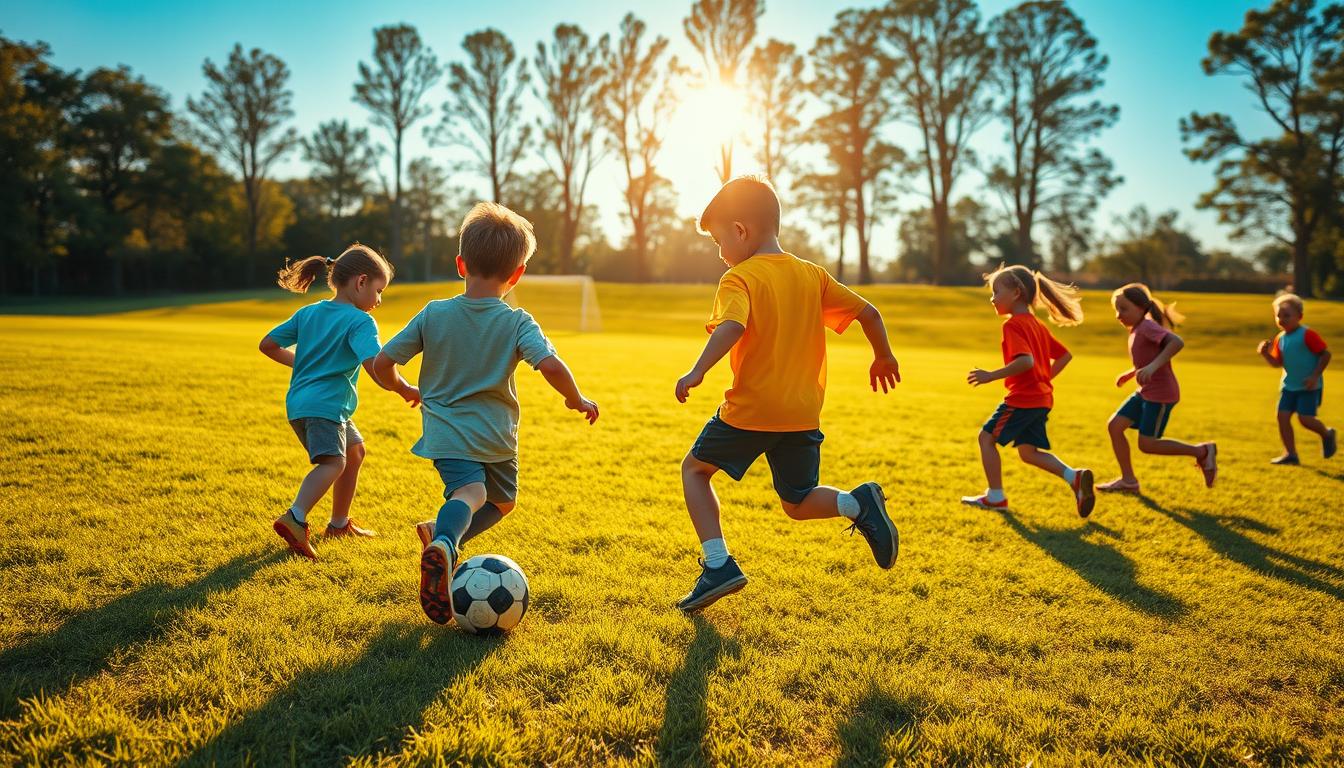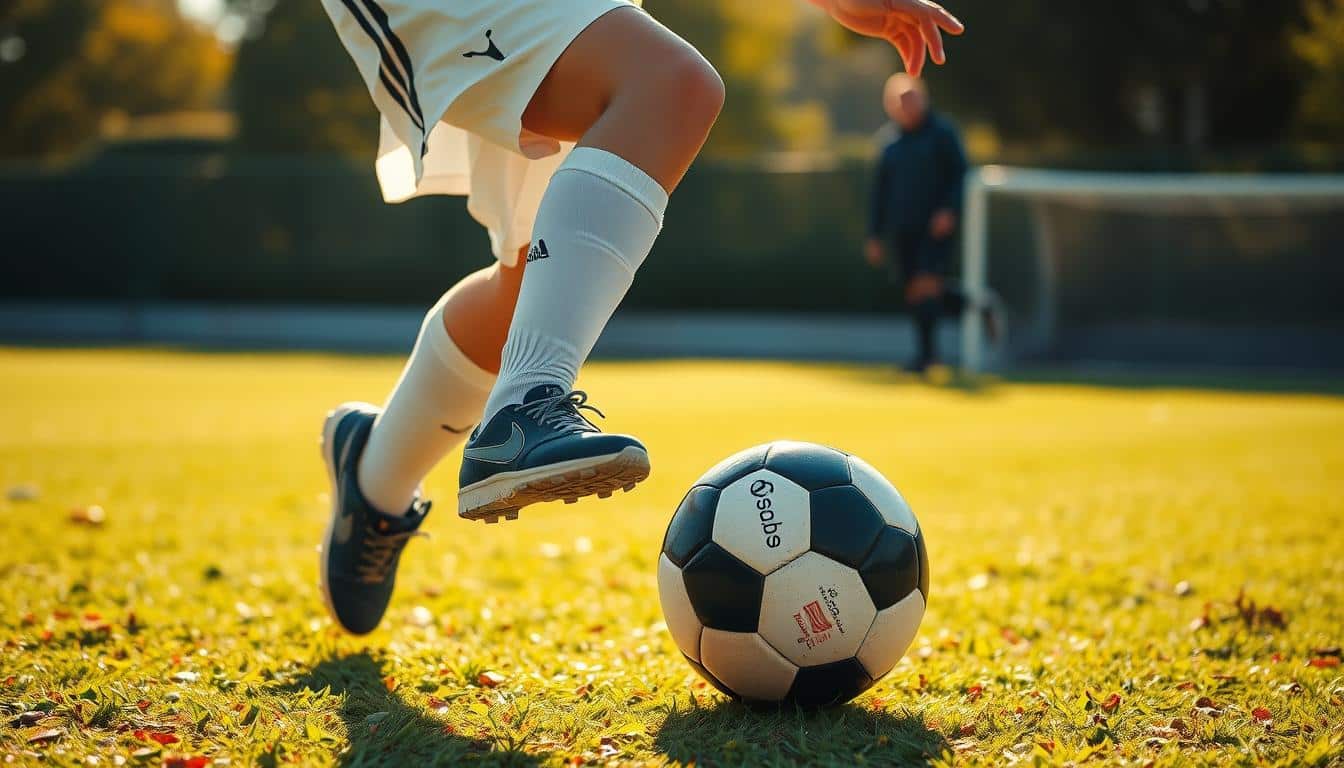How Soccer Improves Kids’ Fitness

Curious which simple activity can boost stamina, confidence, and focus in one go?
I promise you a clear, practical look at the real benefits of this sport for your child. I show easy steps you can try now. You will see how running, sprinting, turning, and ball work build whole-body strength and control.
The game gives steady cardio that supports heart health and better energy. Team play teaches responsibility, time awareness, and fast communication. You will notice calmer moods and sharper focus after practice.
Short practice sessions add stamina and agility. Regular play also helps social skills and lasting healthy habits. I keep the plan simple so you can support your child without stress. Read on for quick wins, then deeper gains in endurance, coordination, and life skills.
Key Takeaways
- Short, regular play builds stamina and better heart health.
- Ball work strengthens coordination and balance.
- Team routines boost responsibility and time skills.
- Practice lifts confidence and improves focus.
- Small steps at home make it easy to stay active.
Quick wins: why playing soccer boosts kids’ health right now
One backyard scrimmage can deliver an hour of heart-pumping action and social time. The CDC asks for 60 minutes of daily physical activity for children. A single practice often covers that.
Motion matters: running, short sprints, small jumps, and quick turns appear in every drill. These moves raise heart rate and help build coordination and physical fitness fast.
Short sessions work: even a 30–45 minute practice gives bursts of cardio. That supports heart health and steady energy through the day. Team games add social play and a safe place to build confidence.
- You can meet the CDC goal with one practice or a backyard play session.
- Even a short scrimmage improves balance at any age or level.
- Simple home goals, like five accurate passes, lock in quick wins and boost mood.
| Time | Activity | Benefit |
|---|---|---|
| 30 min | Sprints & dribbling | Cardio boost |
| 45 min | Small-sided game | Coordination + teamwork |
| 60 min | Practice + cool-down | Endurance & focus |
Cardiovascular fitness and endurance from constant play
Constant movement during a match trains the heart to work harder, then recover, in safe short bursts. This pattern mimics interval training in a natural, game-like way.
Continuous movement builds stamina and heart health
Players spend most of game time moving. Jogging, short sprints, and quick stops keep the heart engaged without long steady strain. Over weeks, that steady work raises endurance and supports cardiovascular fitness.
Game play acts like interval training for youth
Short bursts of speed followed by light jogging create natural intervals. The heart learns to push, then recover. That trains control and helps children last through a full match.
Running, sprinting, and direction changes improve oxygen use
Movement across the field mixes acceleration and direction changes. This improves oxygen delivery to muscles and builds leg power. Repeated practice makes each run feel easier over time.
Key practical points
- Most of the game is movement, which builds steady endurance.
- Bursts plus easy jogs serve as natural interval training.
- Weekly practice locks in gains that grow with time.
| Session length | Main focus | Expected gain | Simple measure |
|---|---|---|---|
| 30 min | Sprints & jogs | Improved short-burst power | Count continuous jog minutes |
| 45 min | Small-sided game | Higher movement and endurance | Touches per player |
| 60 min | Full game + cool-down | Greater stamina and recovery | Jog without stopping time |
Agility, balance, and coordination on the field
Quick footwork and steady balance make a real difference on the field. These traits help young players move safely and think faster during play.

Footwork and quick turns sharpen reaction time
Short drills teach the feet to move before the brain overthinks. A ladder drill or cone weave trains fast feet and sharp direction changes.
Try this at home: set a short ladder or cones and run simple patterns. Start slow. Raise the range only when movements look calm and smooth.
Ball control and body control build balance and core strength
Close dribbles and soft touches link foot work to body control. These moves protect ankles and knees during sudden stops.
- Fast footwork ladders and cone weaves boost agility and reduce slips.
- Touches with inside and outside of the foot improve essential skills and quick reactions.
- Tight turns and light dribbles raise balance and core strength safely.
- Short home practice—five minutes of toe taps or sole rolls—adds clean touches without stress.
- Praise steady posture and smooth turns to reward good form over speed.
| Drill | Focus | Simple measure |
|---|---|---|
| Ladder | Foot speed | Steps per run |
| Cone weave | Direction change | Time to finish |
| Close dribble | Ball control | Touches per minute |
Teamwork, communication, and discipline that support fitness
When a group shares clear goals, every player keeps active and focused on the next play. Teamwork ties motion to purpose: each pass, press, and run matters for the whole group.
Clear calls, quick decisions, and shared goals keep players active
Communication matters. Simple calls like “man on” or “turn” cut mistakes and speed decisions. That keeps the pace high and bodies moving.
Discipline shows up in small habits. Arriving on time, bringing gear, and rotating roles teach responsibility and time management.
- Teamwork keeps every child moving because each action supports the next play.
- Small passing triangles build skills and trust, helping shy players speak up.
- Quick huddles and clear goals — keep shape or win the ball back in five — drive effort.
- Friends on the team make practice feel like play, which raises weekly activity.
| Focus | What it builds | Simple parent tip |
|---|---|---|
| Calls & cues | Fast decisions, less idle time | Encourage short, loud phrases |
| Rotations | Understanding team roles | Ask coach about position swaps |
| Chores chart | Discipline & reduced stress | Link practice to small home tasks |
I suggest you praise good work rate and smart communication, not just a single goal or flashy move. That reward keeps effort steady and learning joyful.
Mental health, confidence, and healthy habits that last
Regular play gives children clear, measurable progress that feeds self-belief and motivation. As skills grow, confidence rises and practice becomes something they want to do.
Skills gains raise confidence and motivate practice
Small wins—an accurate pass, a neat turn—build visible progress. That progress nudges a child to try again.
Keep praise focused on effort and learning. This helps confidence stick and encourages steady development.
Active play reduces stress and supports recovery with sleep
Movement and team time release endorphins that lift mood. Social contact eases stress and builds resilience.
Regular sessions also help children settle at night, which supports deeper, more reliable sleep.
Accessible gear and community programs build lifelong activity
Basic gear is simple: a ball, proper shoes, and comfy clothes. Play works on grass, turf, or concrete.
- Pack a water bottle, light snack, and set a routine packing time to keep practice simple.
- Many community centers or school programs offer low-cost or loaned equipment.
- Find local options or read youth soccer tips at youth soccer tips to match age and schedule.
| Action | Benefit | Time |
|---|---|---|
| Two sessions per week | Steady habit & momentum | 1–3 months |
| One short home drill | Boosts skill and confidence | 5–10 minutes |
| Join community group | New friends and support | Varies |
Simple, steady steps link play to long-term health and positive life habits. A couple of sessions each week can give your child an opportunity to grow friendships, stay active, and carry healthy choices through life.
Conclusion
I recommend a simple plan you can start this week. Pick two days, bring a ball, and focus on one or two skills. Short sessions build endurance and steady gains without pressure.
Play regularly: this sport links movement, teamwork, and better confidence. Your child will learn control on the field and grow habits that suit their age and level.
Look for a local program to make practice social and fun. I encourage you to praise effort and endurance, not just a single goal. Small steps lead to lasting benefits and a lifetime of active play.
